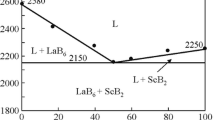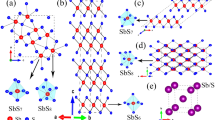Abstract
The Sr3Tl5 phase was prepared by high temperature synthesis techniques through reaction of the high purity elements in the welded Nb tubes. The structure established through X-ray structural analysis shows the compound is a good hypoelectronic trielide example of the Pu3Pd5 structural type in which skeletal electron count is lower than in a traditional Zintl phase (Cmcm, Z = 4; a = 10.604(2) Å, b = 8.675(2) Å, and c = 10.985(2) Å; V = 1010.5(3) Å3). The strontium size and the compound's polarity appear responsible for this thallium phase crystallization in the Pu3Pd5 family type rather than the isoelectronic Sr3In5 version. A first-principle electronic structure calculation (LMTO) demonstrates that the strontium atoms participate substantially in Sr-Tl bonding in the structure.
Similar content being viewed by others
References
Kauzlarich S. Ed. Chemistry, tructure and bonding of Zintl phases and ions. VCH Publishers, New York, 1996
Miller GJ, Lee CS, Choe W. in Inorganic chemistry highlights. Meyer G, Naumann D, Wesemann L. Eds. Germany: Wiley-VCH, Weinheim, 2002, 21–53
Corbett JD. Polyanionic clusters and networks of the early p-element metals in the solid state: Beyond the Zintl boundary. Angew Chem Int Ed, 2000, 39: 670–690
Corbett JD. Exploratory synthesis: The fascinating and diverse chemistry of polar intermetallic phases. Inorg Chem, 2010, 49: 13–18
Zintl E. Intermrtallische verbindungen. Angew Chem, 1939, 52: 1–6
Corbett JD. Polyatomic Zintl anions of the post-transition elements. Chem Rev, 1985, 85: 383–397
Garcia E, Corbett JD. A remarkably diverse interstitial chemistry of the polar intermetallic phase zirconium-antimony (Zr5Sb3). Inorg Chem, 1988, 27: 2907–2908
Nesper R. Bonding patterns in intermetallic compounds. Angew Chem Int Ed, 1991, 30: 789–817
Dong ZC, Corbett JD. Na2K21Tl19, a novel thallium compound containing isolated Tl5 7− and Tl9 9− groups. a new hypoelectronic cluster. J Am Chem Soc, 1994, 116: 3429–3435
Sevov SC, Corbett JD. A remarkable hypoelectronic indium cluster in K8In11. Inorg Chem, 1991, 30: 4875–4877
Dong ZC, Corbett JD. Unusual icosahedral cluster compounds: Open-shell Na4A6Tl13 (A = K, Rb, Cs) and metallic Zintl phase Na3K8Tl13 (how does chemistry work in solids?). J Am Chem Soc, 1995, 117: 6447–6455
Dong ZC, Corbett JD. Na23K9Tl15.3: An unusual Zintl compound containing apparent Tl5 7−, Tl4 8−, Tl3 7−, and Tl5− anions. Inorg Chem, 1996, 35: 3107–3112
Bruzzone G. MX4 compounds of alkaline earth metals with IIIB group elements. Acta Crystallogr, 1965, 18: 1081–1082
Seo DK, Corbett JD. Synthesis, structure, and bonding of open-shell Sr3In5: An unusual electron deficiency in an indium network, beyond the Zintl boundary. J Am Chem Soc, 2001, 123: 4512–4518
Seo DK, Corbett JD. Synthesis, structure, and bonding of hypoelectronic SrIn4: direct example of a dominant size effect in structure selection. J Am Chem Soc, 2000, 122: 9621–9627
Dai JC, Gupta S, Corbett JD. Synthesis, structure, and bonding of BaTl4. size effects on encapsulation of cations in electron-poor metal networks. Inorg Chem, 2011, 50: 238–244
Wendorff M, Röhr C. Binre indide AInx (x = 1, 2, 4; A = Ca, Sr, Ba, K, Rb)-untersuchungen zu strukturchemie und chemischer bindung. Z Anorg Allg Chem, 2005, 631: 338–349
Cromer D. Plutonium-palladium Pu3Pd5. Acta Crystallogr, 1976, B32: 1930–1932
Zhao JT, Corbett JD. Square pyramidal clusters in La3In5 and Y3In5. La3In5 as a metallic Zintl phase. Inorg Chem, 1995, 34: 378–383
Klem MT, Vaughey JT, Harp JG, Corbett JD. A3Tt5 phases Sr3Sn5, Ba3Pb5, and La3Sn5. structure and bonding in a series of isotypic metallic compounds with increased electron count and their comparison with the nominal Zintl phase La3In5. Inorg Chem, 2001, 40: 7020–7026
Zürcher F, Nesper R, Hoffmann S, Fässler TF. Novel arachno-type X5 6− Zintl anions in Sr3Sn5, Ba3Sn5, and Ba3Pb5 and charge influence on Zintl clusters. Z Anorg Allg Chem, 2001, 627: 2211–2219
Cordier G, Schäfer H, Stetler M. Elektronenmangelverbindungen des galliums zur kenntnis von Ca3Ga5. Z Anorg Allg Chem, 1986, 539: 33–38
Dai JC, Corbett JD. Substitution of Au or Hg into BaTl2 and BaIn2. new ternary examples of smaller CeCu2-type intermetallic phases. Inorg Chem, 2006, 45: 2104–2111
Dai JC, Corbett JD. Transformation of AeIn4 indides (Ae = Ba, Sr) into an AeAu2In2 structure type through gold substitution. Inorg Chem, 2007, 46: 4592–4598
Dai JC, Gupta S, Gourdon O, Kim HJ, Corbett JD. BaHg2Tl2. An unusual polar intermetallic phase with strong differentiation between the neighboring elements mercury and thallium. J Am Chem Soc, 2009, 131: 8677–8682
SMART, Bruker AXS, Inc., Madison, WI, 1996
Blessing RH. An empirical correction for absorption anisotropy. Acta Crystallogr, 1995, A51: 33–38
SHELXTL 6.1, Bruker AXS, Inc., Madison, WI, 1996
Andersen OK. Linear methods in band theory. Phys Rev B, 1975, 12: 3060–3083
Andersen OK, Jepsen O. Explicit, first-principles tight-binding theory. Phys Rev Lett, 1984, 53: 2571–2574
Andersen OK, Jepsen O, Glötzel D. In Highlights of Condensed Matter Theory. Bassani F, Fumi F, Tosi MP. Eds. North Holland: New York, 1985
Skriver HL. The LMTO Method. Berlin: Springer, 1984
Jepsen O, Andersen OK. The stuttgart TB-LMTO program, Version 4.7. Max-Plank-Institut für Festkörperforschung, Stuttgart, Germany, 1994
von Barth U, Hedin L. A local exchange-correlation potential for the spin polarized case. i. J Phys C, 1972, 5: 1629–1642
Koelling DD, Harmon BN. A technique for relativistic spin-polarised calculations. J Phys C, 1977, 10: 3107–3114
Jepsen O, Andersen OK. Calculated electronic structure of the sandwich d1 metals LaI2 and CeI2: application of new LMTO techniques. Z Phys B, 1995, 97: 35–47
Lambrecht WRL, Andersen OK. Minimal basis sets in the linear muffin-tin orbital method: Application to the diamond-structure crystals C, Si, and Ge. Phys Rev B, 1986, 34: 2439–2449
Blöchl PE, Jepsen O, Andersen OK. Improved tetrahedron method for brillouin-zone integrations. Phys Rev B, 1994, 49: 16223–16233
Gupta S, Ganguli AK. Evidence of incipient bond-stretching isomerism in Sr2.04(1)Ca0.96(1)Sn5 from variable-temperature structural studies. Inorg Chem, 2005, 44: 7443–7448
Rhode M, Wendorff M, Röhr C. Verbindungen A3M5 (A = erdalkalimetall, M = triel/tetrel): eine fallstudie zur strukturellen und elektronischen stabilität polarer intermetallischer phasen. Z Anorg Allg Chem, 2006, 632: 1195–1205
Kim SJ, Fässler TF. Influence of element substitution on the cluster arrangement in the novel structures Ca3Tl5, Sr3Tl5, and Sr3Sn5−x Tlx (x = 1.8 and 2.2). Z Anorg Allg Chem, 2009, 635: 1925–1932
Wells AF. Structural Inorganic Chemistry. Oxford: Clarendon Press, 5th ed, 1984, 1304
Dong ZC, Corbett JD. K18Tl20Au3, a novel derivative of K8Tl11 with the unprecedented polyanion Tl9Au2 9−, the parent Tl11 7− and an isolated Au− ion. Inorg Chem, 1995, 34: 5042–5048
Author information
Authors and Affiliations
Corresponding author
Additional information
Dedicated to Professor John D. Corbett on the occasions of his 85th birthday
Electronic supplementary material
Rights and permissions
About this article
Cite this article
Li, D., Luo, G., Xiao, Z. et al. Synthesis, structure and bonding of the hypoelectronic cluster compound Sr3Tl5 . Sci. China Chem. 55, 131–137 (2012). https://doi.org/10.1007/s11426-011-4382-z
Received:
Accepted:
Published:
Issue Date:
DOI: https://doi.org/10.1007/s11426-011-4382-z




